[One]
IN THE BRICKS-AND-MORTAR backstory of the wines Dean Hewitson has made for 25 years, I hear a little echo of Willy Wonka.
It could almost be a chapter from a children’s history book: across South Australia, generations of 20th century school kids—Dean included—received small, foil-topped bottles of milk during their lunch breaks, packed up by the old Adelaide Milk Factory at what were, back then, the industrial outskirts of town. In more recent years, the historic operation gave way to Haigh’s Chocolates, an equally venerable Australian sweets company that took over the 100 year-old warehouse in Adelaide’s Mile End neighborhood in 2010.
Of course, there was never a Wonka-like character offering quasi-psychedelic, technicolor tours to children and their parents. But the combination of childhood memories and chocolate-making brought a smile to my face when Dean told me about the place where, for a decade in between the cows and confections, he built Hewitson Wines into an essential South Australian wine brand.
To borrow an Aussie term, a few walkabouts helped get him there.
As I wrote about earlier this year in part one, Dean studied from 1990 to ’92 at UC Davis, earning a master’s degree in its Viticulture and Enology program. He’d already gotten a foothold in the industry working under the renowned vintner Brian Croser at Petaluma Winery, then took advantage of his time in California to explore wine regions along the West Coast. And during sojourns before and after Davis, he traveled and worked in France to learn about its wines and gain some of the practical experience that would go on to benefit him in his career.
After a second go-around at Petaluma in the mid-90s, Dean felt ready in 1997 to initiate his own winemaking project at home in Adelaide. “Unfortunately we didn’t have a lot of money, but I convinced my wife that it was a good idea,” he told me over the phone at the conclusion of the ’21 harvest, back when I’d first landed on the idea to write about Hewitson Old Garden mourvèdre. “We really started from scratch.”
 More recently, he took the time in a combination of phone calls and emails to paint a detailed picture of how the venture came together. The scenario he described was probably no one’s idea of a winemaking operation—except his.
More recently, he took the time in a combination of phone calls and emails to paint a detailed picture of how the venture came together. The scenario he described was probably no one’s idea of a winemaking operation—except his.
Lacking capital at the time to buy or build a winery, and also just starting a family in Adelaide with his wife, Lou, he wanted to keep the business local. He settled on the idea to custom-crush—i.e. rent winery space to crush his wine grapes—but otherwise have complete, on-site control over the fermentation and barrel-aging of the Hewitson wines and their eventual distribution out to Australian and other markets. One way or another, it would require a facility of his own.
“I was searching around for a place to work from, and I came upon this old milk factory,” he wrote in one of his emails. The building he remembered from childhood “was sort of like a dairy, but it sort of wasn’t because they didn’t milk the cows there. They brought all the milk from the dairy farms back to Adelaide.”
He shared the vivid memory of discovering room after room in the empty factory, which sat at the periphery of Adelaide’s central business district and was, he noted, the oldest refrigerated building in South Australia.
“It was where the railyards come in, sort of on the edge of the city,” he separately recalled over the phone. It was both an informative and amusing call. “Of course, they’d just deserted the place, and they left milk bottles there in crates. So we gave these rooms names. There was a pale of smelly old milk in one of them that had turned into rotten cheese.” Naturally, he laughed, they called it “the Cheese Room.”
Despite some of the off-putting conditions inside the factory, Dean found a willing enabler of the project to convert it to a winemaking space. “The landlord who owned of the building, you know, he and his family were great,” he said. “They sort of gave me a real go.”
Meanwhile, he lined up multiple custom crush arrangements through some friendly wineries so that, as he explained, “I could pick when I wanted to pick rather than being beholden to the logistics of just one particular winery.” Immediately after they were pressed at these facilities, he had the still-fermenting red wines transported in tankers back to Mile End.
And here was when the factory’s new-found usefulness really came into play. He described a century-old structure that was “two stories of concrete, divided into cellars with cork-lined walls, and actually housed the first commercial refrigeration unit in South Australia.” Though defunct when the Hewitson operation moved in, it still contained the stainless steel tanks and old pumps that had been used for milk bottling.
“It was just an amazing place. It had everything!” Dean enthused, telling me how he took creative advantage of the discarded equipment. “I would unload the tankers into stainless steel, then gravitate to barrel where the wines would finish fermentation.”
The new wines did their maturation in the cool, damp makeshift cellars, and when ready he would empty the barrels back into the stainless steel tanks. Trucks arrived and transported the tankered wines to be bottled off-site. “Post-bottling,” he continued in his email, “a semi-trailer would bring the bottled and palletised wines back to the milk factory, and we would dispatch from there, close to all the transport and close to the port.”
He pointed out that, as the sole tenant for a number of years, he only ever used the ground floor of the factory. The second floor functioned as extra insulation, with the temperature remaining a constant 15 Celsius—an ideal situation for storing barrels in Adelaide’s warm climate.
• • • • •
The Hewitson brand launched in 1997 and expanded at a steady pace over the ten years Dean spent in Mile End on a month-to-month lease. On one of our calls he told me that, 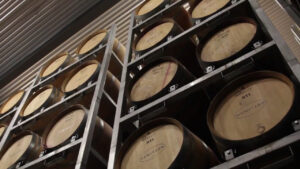 during this earlier phase, he grew it to what is almost the winery’s current production size. “As I bought more barrels, and as the business expanded, my landlord let me extend into other cellars.”
during this earlier phase, he grew it to what is almost the winery’s current production size. “As I bought more barrels, and as the business expanded, my landlord let me extend into other cellars.”
“They were a great landlord family,” he added, reiterating his gratitude to the building’s owners who facilitated the winemaking project. “They helped me incredibly.”
Another of his enablers got credited in our conversations: his late friend and exporter, John Larchet, whom I also knew. As proprietor of The Australian Premium Wine Collection, the Irish-Australian had personally turned me onto Dean’s wines (and a number of other excellent brands) in the early 2000s in San Francisco. Hewitson had, by this point, come out of its startup phase. Almost from the start, Larchet supported the effort at what he liked to call “the old dairy.”
As it turned out, the project near Adelaide’s central business district was running on borrowed time. In 2006, Hewitson got caught in a familiar pattern of urban renewal, not too different from what might have occurred in Downtown Los Angeles or Brooklyn around the same period. The landlord informed Dean that a plan was in motion to tear down and rebuild the part of the factory he was occupying. Commensurate with the gentrification of the neighborhood, the rent would need to increase. “They were seeking a long-term tenant,” he wrote in his email. “It really wasn’t good for much else than the purpose I had come up with for it.”
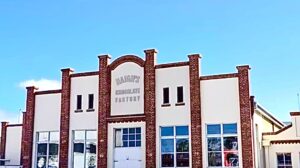 By this time, he found himself in something of an olfactory sandwich: Hewitson sat between SAFCOL, an old fish market co-op in the neighboring building—they shared a wall—and Haigh’s Chocolates, which had taken over a back section of the factory. “We were successful in blocking that wall off so no fishy smells came through it,” he laughed at one point over the phone.
By this time, he found himself in something of an olfactory sandwich: Hewitson sat between SAFCOL, an old fish market co-op in the neighboring building—they shared a wall—and Haigh’s Chocolates, which had taken over a back section of the factory. “We were successful in blocking that wall off so no fishy smells came through it,” he laughed at one point over the phone.
Dean knew that the confectioners had begun working in a refurbished section of the factory, a “modernised, tiled, and properly drained area adjacent to the cellars and the stainless steel tanks,” though these visual clues he shared of the Haigh’s operation probably haven’t stuck with him like the more pleasantly aromatic memory of what was being made next door.
“Seriously, it was such a beautiful aroma. The smell of chocolate drifting through the cracks in the walls was amazing,” he recalled, reconnecting to the past at Mile End in a perfectly Wonka-esque moment—before acknowledging that it had to literally come crashing down.
“I knew that they were going to demolish the building and rebuild it. So that actually gave me time to get organized and look for a place. And Barossa Valley was the obvious choice for me.”
[Two]
When JV Wine & Spirits, my former go-to source for the singular Hewitson mourvèdre from Old Garden Vineyard, closed its doors in 2012, it did so at its second location in Napa’s Oxbow District. JV’s original address was across and just down First Street, a stone’s throw from the Napa River.
The standalone 1955 building, according to my Los Angeles architect friend Warren Techentin, recalled “the big-roofed farm/barn structures of yore,” as he put it in an email after I’d sent him a realtor’s stock photo of the now-bulldozed property. He believed that at 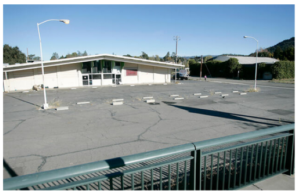 some point in the building’s past, “many large panes of glass had once ‘graced’ the facade with a big open gesture to the community and the warmth of its light at night”—an observation that reminded me why I look to an expert for this type of help in the first place: the location always struck me as pretty dull. “It seems,” Warren also suggested, “as if the building had a more optimistic past.”
some point in the building’s past, “many large panes of glass had once ‘graced’ the facade with a big open gesture to the community and the warmth of its light at night”—an observation that reminded me why I look to an expert for this type of help in the first place: the location always struck me as pretty dull. “It seems,” Warren also suggested, “as if the building had a more optimistic past.”
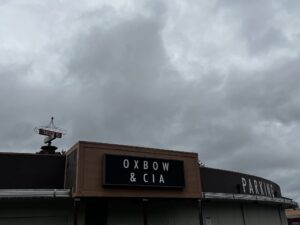 Whatever optimism its designer brought to it back in the 1950’s, that goodwill was used up nearly seven decades later: the late-modern structure only exists in photos, memories, and city records; the acre of grassy-gravelly real estate underneath it, long rumored to someday get transformed into a Ritz-Carlton hotel, functions unglamorously as an occasional parking lot for the Oxbow RiverStage concerts nearby. Meanwhile, the second—also former—JV location across the street, which opened part one of this Aussie mourvèdre story, has sat empty for eleven years and counting. It’s just another parking lot, this one for the Oxbow Market and the CIA’s Napa campus at Copia.
Whatever optimism its designer brought to it back in the 1950’s, that goodwill was used up nearly seven decades later: the late-modern structure only exists in photos, memories, and city records; the acre of grassy-gravelly real estate underneath it, long rumored to someday get transformed into a Ritz-Carlton hotel, functions unglamorously as an occasional parking lot for the Oxbow RiverStage concerts nearby. Meanwhile, the second—also former—JV location across the street, which opened part one of this Aussie mourvèdre story, has sat empty for eleven years and counting. It’s just another parking lot, this one for the Oxbow Market and the CIA’s Napa campus at Copia.
It all reminds me of another boozy emporium, one that used to connect lots of Australian wine dots for me and is, thankfully, still alive and kicking in San Francisco: The Jug Shop.
• • • • •
During the mid-to-late 2000s, while Dean was in the process of transitioning from the Adelaide Milk Factory to his new winery under construction in the Barossa Valley town of Nuriootpa, someone from John Larchet’s U.S. importing team (or perhaps the man himself) was doing a bit of business here in Napa. If that sounds like the Australian version of bringing coals to Newcastle, then Chuck Hayward had some hand in the folly.
Chuck, who showed up in part one, is a good friend in San Francisco and also one of my oldest wine business colleagues. In my early wine-slinging days, as a minion at Coit Liquors in North Beach in 1992 and ’93, I occasionally (and gleefully) got to escape to make deliveries around San Francisco in the store’s panel van. In the meantime, Chuck was well into the process of building a retail Shangri-La for Aussie wine enthusiasts a mile away on Pacific Avenue. The Jug Shop’s original location is where we first met on one of those delivery days, and where he invited me one spring afternoon to sit down with the owner and talk about a job that likely involved similar retail drudgery but would no doubt have been more fun. Instead, I went to work for Bill Easton at Solano Cellars in Albany, who also became a great friend and colleague—but that’s another story.
Across the U.S., Chuck’s name is more or less synonymous with Australian wine, a distinction he’s earned over decades of working to grow the reputations of that country’s, and New Zealand’s, artisan growers and winemakers. His campaign began in earnest at The Jug Shop, where he started as a buyer in the mid-80s and stayed on until 2009. Today, he owns and operates Vinroads, a marketing and education consultancy for Australian and New Zealand wines. Looking back, there are probably few U.S. importers of these products he hasn’t engaged with on some level over the last 25-plus years. Unsurprisingly, he and John Larchet met each other and did business at the legacy San Francisco retailer.
Chuck’s former employers moved their eclectic store three times in two decades, all within a two-block radius of Pacific and Van Ness Avenues, which is how I connect it to JV Wine & Spirits. My favorite Napa shop relocated across the street only once, and was perhaps a little less colorful a place to frequent, but it maintained a similarly local and quirky vibe for all the years I was a customer.
If JV eventually died on the sword of being, as its motto went, the place “Where the Napa Valley shops for wine,” then The Jug Shop’s San Francisco customers lived for wines of the Antipodes during Chuck’s enthusiastic tenure. That situation has pretty much changed at its current location, a decommissioned fire station just down the street from Harris’ Restaurant, one of the city’s old standbys.
While the cavernous, Mission Revival space possesses character and even clings to the memory of its earlier purpose (a fireman’s pole still descends from a hole in the shop’s ceiling), the Australian pickings are slimmer these days. One time, not too long ago, I did discover a Chuck-inspired holdover, a shiraz from a McLaren Vale winery, Battle of Bosworth. I’ll admit I bought it mostly for the label: the dramatic naming flourish was one I could appreciate, along with the twenty dollar price. It turned out to be a great find.
(On a separate visit last year, I picked up another label that was new to me: a very old-vine Contra Costa mataro from Erggelet Brothers, made by eponymous, German winemaker-siblings from the sandy soils of the Del Barba Vineyard in Oakley in a style that reminds me of Dean’s Old Garden mourvèdre.)
To this day, I’ve only met a handful of wine professionals, including importers, influential retailers, capital-M masters of this or that wine discipline, and even career vintners, who are as fully into their trade as much as Chuck is captivated by the Aussie-Kiwi wine category he and his staff championed at The Jug Shop. In the wake of that team effort, it can’t be easy to operate a one-man marketing outfit, self-tasked with pushing the proverbial southern hemisphere wine barrel uphill. Still, I think he’s doing his life’s work.
• • • • •
Living in San Francisco, Chuck is a lot easier to connect with in person than Dean. One time, coming out of the pandemic and early in my Hewitson mourvèdre inquiry, I spent an afternoon with him and his girlfriend, Paige Granback, at their Russian Hill apartment. We opened a bottle of 2015 Old Garden that Dean’s New York Importer, Frederick Wildman Company, had helpfully shipped to me.
In keeping with his Vinroads mission, Chuck had a few other interesting bottles lying around. He pulled out a trio of fantastic (and very expensive) Barossa shirazes made by Chris Ringland, along with an unusually old Barossa riesling from Rockford winery that he  later blogged about here.
later blogged about here.
As I almost always do when I get to taste and talk about Australian wines with Chuck, I learned something new—in this instance that, unlike the Ringland and other shiraz wines, Dean’s Old Garden mourvèdre was a bit of an outlier for the Barossa Valley category: not the grape variety’s presence in this part of South Australia, but rather for winemakers using it in standalone bottlings, as opposed to its more traditional role in “GSMs,” or grenache-shiraz-mourvèdre wines. Back in The Jug Shop days and up to the present, he explained, Barossa and other South Australian reds made entirely from mourvèdre were, and are, unusual. Only a small handful ever landed on his radar and allowed him to consider the grape on its own.
“One of the questions about mourvèdre is ‘What is the real mourvèdre?’” Chuck asked, standing at the kitchen counter while Paige worked within earshot in the next room. He poured the bottle of Old Garden into a large Pyrex measuring cup—his decanter of last resort, I guessed. “For me, it was always kind of structured, kind of inky, but not showing a lot of prettiness. It’s always been more of a component than a 100% varietal wine. Dean was one of the first guys to really do this type of bottling, along with d’Arenberg and their Twenty Eight Road from McLaren Vale. Those were the first 100% mourvèdres that we saw here.”
Pouring out a couple of tastes, he dropped the familiar acronym. “When the GSM thing started, what I really liked about the way Aussies did those blends was the precision of the blends: you tasted the grenache up-front. It was the juice that carried the wine, whereas the shiraz gave it the power, and the mourvèdre gave you the structure.”
(“Like Rosemount Estate and their GSM!” he suddenly exclaimed, reminding me about a once-ubiquitous brand name. “Remember that wine?”—I did, very well—“That shit was flying out the door at The Jug Shop!”)
 Chuck pointed out that grenache—the “G”—was, percentage-wise, typically the lead grape variety in such blends, but that some vintners would switch things up and make a “GMS” wine with a greater amount of mourvèdre than shiraz. It followed, he noted, that “you could see a little bit more tannin and more structure in a GMS blend. And so it was like, with the ability of Aussie winemakers to take those grapes and blend them to a style in their heads, it was just awesome.”
Chuck pointed out that grenache—the “G”—was, percentage-wise, typically the lead grape variety in such blends, but that some vintners would switch things up and make a “GMS” wine with a greater amount of mourvèdre than shiraz. It followed, he noted, that “you could see a little bit more tannin and more structure in a GMS blend. And so it was like, with the ability of Aussie winemakers to take those grapes and blend them to a style in their heads, it was just awesome.”
He smelled and sipped the Old Garden in his glass. “This mourvèdre has always been really different. I’ve been drinking this wine since John Larchet brought it in. It was powerful but always pretty, you know? It’s got this Burgundian pinot-like character. It’s not the blocky-chunky style of mourvèdre.”
Then he paused to confess that, while he’s known Dean for years and spent more time in Barossa Valley than most other American wine professionals, he’d never been to visit Old Garden or the current Hewitson winery facility. But on a trip a number of years ago to Adelaide, he and Paige did carve out time to see Dean and taste his wines at the previous location in Mile End. He smiled at the memory and was about to compare that unique facility to what a visitor might find in, say, Napa Valley, when Paige, who’s traveled to Australia with Chuck half a dozen times, interrupted him. “The Hewitson winery at the old dairy?” she chimed in from the other room, also laughing. “It was like controlled chaos!”
“It was a little chaotic,” he agreed, “but they could thank his wife, Lou. She kept it under control.”
We got back to the subject at hand in the Pyrex cup. “But what is it that makes this particular wine different than most other mourvèdres?” Chuck wondered, adding a layer to the question. “Mourvèdre is having a big renaissance in the Barossa Valley right now. It’s the hot thing. It’s actually the smallest number of grapes grown in the Barossa in terms of percentages, so the prices are going out the roof. People are looking for old-vine mourvèdre, and it’s just jumping. These guys have some”—he tapped the Rockford bottle—”and they sell it to Torbreck, I think. But finding old-vine mourvèdre grapes like Dean has is a big deal these days.”
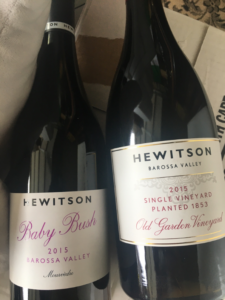 As I mentioned above, the Frederick Wildman folks shipped me a couple of sample bottles of 2015 Old Garden for this article (they also sent a bottle of ’15 Baby Bush, a young-vines mourvèdre that Dean noted is an example of “Selection Massale,” or vine cuttings, from Old Garden—a delicious, value-priced wine worth seeking out). If I’d purchased Old Garden in a shop or through an online retailer, it would’ve set me back $70 or $80 per bottle—not a cheap price but, I believe, a fair one for such a singular wine (and three or four times what I’d paid years earlier at JV in Napa). I wondered if, back at his cellar door in Nuriootpa, Dean had decided to start charging his customers a price more reflective of Old Garden’s profile as one of the world’s great mourvèdre vineyards and bottlings, as opposed to it being the supply-and-demand scenario laid out by Chuck. It was probably a combination of both.
As I mentioned above, the Frederick Wildman folks shipped me a couple of sample bottles of 2015 Old Garden for this article (they also sent a bottle of ’15 Baby Bush, a young-vines mourvèdre that Dean noted is an example of “Selection Massale,” or vine cuttings, from Old Garden—a delicious, value-priced wine worth seeking out). If I’d purchased Old Garden in a shop or through an online retailer, it would’ve set me back $70 or $80 per bottle—not a cheap price but, I believe, a fair one for such a singular wine (and three or four times what I’d paid years earlier at JV in Napa). I wondered if, back at his cellar door in Nuriootpa, Dean had decided to start charging his customers a price more reflective of Old Garden’s profile as one of the world’s great mourvèdre vineyards and bottlings, as opposed to it being the supply-and-demand scenario laid out by Chuck. It was probably a combination of both.
Eventually, Paige took a break from her work and joined in our tasting. The three of us continued to ponder this wine made from vines planted well before the U.S. Civil War.
“Old Garden has always had this elegance,” Chuck observed—this coming from a guy whose right to be jaded about Australian wine must supersede anyone else’s in this country. But jadedness isn’t his style; it was rather the opposite, at least on that post-pandemic day in his and Paige’s kitchen. “I just think—I’m not sure if it’s clonal in the vineyard, or simply the way Dean makes it, or something else—this wine is what I’d call sui generis. It is of its own thing. To this day, I’ve never tasted a mourvèdre from Barossa like this.”
[Afterword]
One time last year, Chuck had a surprise for me. On a sunny November day when he knew I was going to be in San Francisco, he invited me to meet him at The Jug Shop and taste some older Hewitson wines.
 I arrived at Pacific and Polk in the afternoon and made my way to the back of the old fire station, where the exit doors open up onto a patio and wine tasting area. Rows of outdoor lights are strung over the fenced-in space, which must lend a festive vibe after dark. I thought back to Dean and his vision for an old milk factory in Adelaide. This latest version of the store was another example of repurposed urban real estate. I wondered if earlier generations of the SFFD’s Engine Company No. 8 had utilized the patio for their own entertainment. Pots of cioppino, jugs of Gallo, and firefighter camaraderie were easy to picture.
I arrived at Pacific and Polk in the afternoon and made my way to the back of the old fire station, where the exit doors open up onto a patio and wine tasting area. Rows of outdoor lights are strung over the fenced-in space, which must lend a festive vibe after dark. I thought back to Dean and his vision for an old milk factory in Adelaide. This latest version of the store was another example of repurposed urban real estate. I wondered if earlier generations of the SFFD’s Engine Company No. 8 had utilized the patio for their own entertainment. Pots of cioppino, jugs of Gallo, and firefighter camaraderie were easy to picture.
Chuck keeps a stash of his personal wine and Vinroads client samples in the store’s cellar. As I arrived, he went into it and came back with a few bottles, including yet another old Aussie riesling—this one a 2004 Eden Valley from Wolf Blass—and a trio of 2005 and ’06 Hewitson reds. No corkscrews were needed: almost twenty years ago, for better (wine integrity) or worse (the planet), many Australian vintners were well into their transition to Stelvin and other screwcap enclosures.
He set the bottles out on a long table that takes up a section of the p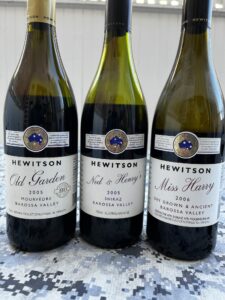 atio. The star of the show was, no surprise, an Old Garden mourvèdre from the excellent ‘05 vintage. Chuck also pulled out a couple of wines that Dean continues to produce today: a 2005 Ned & Henry’s Barossa Valley shiraz and an ’06 Miss Harry Barossa GSM (“She’s from vineyards dating back to the late 1800s,” someone—quite possibly Dean—wrote for the side label copy. “She’s All Australian.”)
atio. The star of the show was, no surprise, an Old Garden mourvèdre from the excellent ‘05 vintage. Chuck also pulled out a couple of wines that Dean continues to produce today: a 2005 Ned & Henry’s Barossa Valley shiraz and an ’06 Miss Harry Barossa GSM (“She’s from vineyards dating back to the late 1800s,” someone—quite possibly Dean—wrote for the side label copy. “She’s All Australian.”)
As was the case previously in his and Paige’s apartment, our tasting that day was a Hewitson tutorial, and Chuck connected it to Eden Valley, McLaren Vale, and other Australian regions that comprise his wheelhouse of longtime expertise. If that country has a de facto wine industry educator in the U.S., I think he has to be the guy.
“Winemakers and grape growers are very curious people,” he’d told me on an earlier call from Virginia, where he goes on occasion with Paige to visit her family. “You know, they’re inquisitive. I’m inquisitive. I love the wine business for all of this because I can see one little thing, whatever it is—in the vineyard, in the cellar—and it changes the way the wine tastes.”
He described sharing what he called “expansive knowledge” with his former customers. “I can take three glasses of wine, and to average punters at The Jug Shop I can say, ‘Here you go: which one do you like? Which one do you hate? Which one is in the middle?’ And they say, ‘I like that one, I hate that one, and that one was OK.’ And I’ll say, ‘The reason that’s different is because of X, whatever X is: weather, oak, soil, et cetera.’ And they go, ‘Wow, that’s pretty cool. I learned something.’ And they walk away a better customer.”
He told me he was pretty sure back then, and remains so today, that people are smarter about wine than they think. “They’re just not presented the information the right way. So when they say, ‘Oh yeah. Now I know to ask for some oak on the wine,’ or ‘I like French wine,’ or ‘I don’t like tannic wine,’ or whatever the case may be, they become better consumers.
“All the knowledge that guys like you and I get when we go out there and visit wineries,” Chuck added, “that’s what I use it for. It’s to make our customers smarter.”
[End of Part Two — there might be a third…]
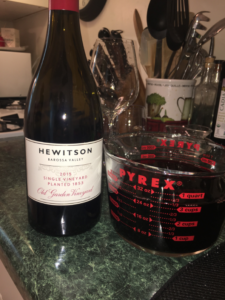

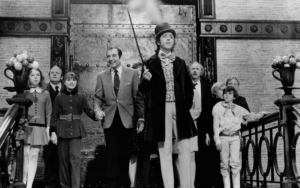
Thanks for this great article. When is the book coming?